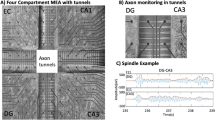Summary
Maintained activity in the absence of light was recorded from the exposed pineal organ (Epiphysis cerebri) of the rainbow trout (Salmo irideus) by means of microelectrodes. Inhibitory responses to light were obtained from pineal ganglion cells (single unit responses) as well as from the pineal tract (mass responses) of specimens deprived of their lateral eyes. The most sensitive units responded to white light of 1 sec duration at 3 · 10−5 lm/m2 (mass responses) and with 7 · 10−5 lm/m2 (single units). A still lower light threshold of 2,5 · 10−6 lm/m2 was found when the lowermost steady illumination was determined which raised the dark threshold. During exposure to steady illumination the maintained activity decreases almost linearly with the logarithm of light intensity. A decrease to about 50 per cent was obtained if the illumination was increased to 2.500 lm/m2. The distribution of spectral sensitivity of the inhibitory effect of light varied among different pineal neurons. Curves exhibiting maxima between 500 and 533 mμ were seen. No Purkinje shift was observed during light adaptation. In some experiments inhibitory effects to short wavelengths and excitatory responses to long wavelengths were recorded (chromatic responses).
Zusammenfassung
Mikroelektrodenableitung vom freigelegten Pinealorgan der Regenbogenforelle (Ableitung von einzelnen Ganglienzellen der Epiphysis cerebri bzw. Massenentladung von Nervenfasern des Tr. pinealis) zeigt eine spontane Impulsaktivität, die durch Belichtung gehemmt wird und auch nach Entfernung der Lateralaugen bestehen bleibt. In der Regel ist die Antwort unabhängig von der Wellenlänge des Reizlichts (achromatische Antwort), doch wurden in einigen Versuchen auch chromatische Antworten beobachtet. Die für eine Reihe von Pinealorganen bei Salmo irideus bestimmte absolute (Hemmungs-)Schwelle liegt bei 3 · 10−5 lm/m2 (Massenentladung) und bei 7 · 10−5 lm/m2 (Einzelneurone) gegenüber Lichtreizen von 1 sec Dauer, und bei 2,5 · 10−6 lm/m2 gegenüber Dauerlicht. Dauerlicht vermindert die Frequenz der Spontanaktivität mit einem Halbwert bei 2500 lm/m2. Eine Purkinje-Verschiebung wird nicht beobachtet. Die Maxima der Spektralsensitivität der einzelnen Pinealneurone variieren zwischen 500 und 533 mμ.
Similar content being viewed by others
Literatur
Breder, C. M., and P. Rasquin: A preliminary report on the role of the pineal organ in the control of pigment cells and light reactions in recent teleost fishes. Science 111, 10–12 (1950).
Breucker, H., u. E. Horstmann: Elektronenmikroskopische Untersuchungen am Pinealorgan der Regenbogenforelle (Salmo irideus). Progr. Brain Res. 10, 259–269 (1965).
Bridges, C. D. B.: The visual pigments of the rainbow trout (Salmo irideus). J. Physiol. (Lond.) 134, 620–629 (1956).
Dartnall, H. J. A.: The interpretation of spectral sensitivity curves. Brit. med. Bull. 9, 24–30 (1953).
Dodt, E.: Photosensitivity of the pineal organ in the teleost, Salmo irideus (Gibbons). Experientia (Basel) 19, 642–643 (1963).
——, and E. Heerd: Mode of action of pineal nerve fibers in frogs. J. Neurophysiol. 25, 405–429 (1962).
——, and M. Jacobson: Photosensitivity of a localized region of the frog diencephalon. J. Neurophysiol. 26, 752–758 (1963).
——, and K. H. Jessen: The duplex nature of the retina of the nocturnal gecko as reflected in the electroretinogram. J. gen. Physiol. 44, 1143–1158 (1961).
——, u. Y. Morita: Purkinje-Verschiebung, absolute Schwelle und adaptives Verhalten einzelner Elemente der intrakranialen Anuren-Epiphyse. Vision Res. 4, 413–421 (1964).
Friedrich-Freksa, H.: Entwicklung, Bau und Bedeutung der Parietalgegend bei Teleosteern. Z. wiss. Zool. 141, 52–142 (1932).
Frisch, K. v.: Beiträge zur Physiologie der Pigmentzellen in der Fischhaut. Pflügers Arch. ges. Physiol. 138, 319–387 (1911).
Hoar, W. S.: Phototactic and pigmentary responses of sockeye salmon smolts following injury to the pineal organ. J. Fish. Res. Bd. Canada 12, 178–185 (1955).
Hill, Ch.: The epiphysis of teleosts and amia. J. Morph. 9, 237–268 (1894).
Miller, W. H., and M. L. Wolbarsht: Neural activity in the parietal eye of a lizard. Science 135, 316–317 (1962).
Morita, Y.: Erregung und Hemmung pinealer Neurone der Regenbogenforelle (Salmo irideus) bei Belichtung des Zwischenhirns. Pflügers Arch. ges. Physiol. 283, R 30 (1965).
—— Extra- und intracelluläre Ableitungen einzelner Elemente des lichtempfindlichen Zwischenhirns anurer Amphibien. Pflügers Arch. ges. Physiol. 286, 97–108 (1965).
——, and E. Dodt: Nervous activity of the frog's Epiphysis cerebri in relation to illumination. Experientia (Basel) 21, 221–222 (1965).
Oksche, A.: Persönliche Mitteilung.
Schäfer, O.: Spektrale Empfindlichkeit und absolute Schwelle des Farbwechsels geblendeter Elritzen (Phoxinus phoxinus L.). Biol. Zbl. 83, 47–66 (1964).
Wald, G.: On the distribution of Vitamin A1 and A2. J. gen. Physiol. 22, 391–415 (1939).
—— The visual systems of euryhaline fishes. J. gen. Physiol. 25, 235–245 (1941).
Author information
Authors and Affiliations
Additional information
Mit Unterstützung der Deutschen Forschungsgemeinschaft.
Auszugsweise vorgetragen auf der 30. (Frühjahrs-)Tagung der Deutschen Physiologischen Gesellschaft, Bad Nauheim 1965 [15].
Rights and permissions
About this article
Cite this article
Morita, Y. Entladungsmuster pinealer Neurone der Regenbogenforelle (Salmo irideus) bei Belichtung des Zwischenhirns. Pflügers Arch. 289, 155–167 (1966). https://doi.org/10.1007/BF00412906
Received:
Issue Date:
DOI: https://doi.org/10.1007/BF00412906




